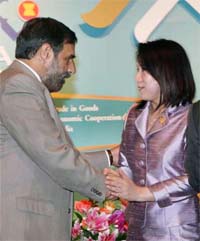According to the study done by ICRIER on this subject in relation to exports to ASEAN countries, it emerged that unlike few other trading blocks, the overall trade of India to ASEAN has not been trade diverting. This is in keeping with the spirit of WTO norms, and thus is expected to further strengthen the multilateralism. Furthermore, from 2000-2008, ASEAN member states’ trade with the rest of the world has doubled (fig1). Thus, the increase in trade between India and ASEAN should be considered in conjunction with the expansion in multilateralism—which is the ultimate goal of a world economy seeking to achieve the optimum level of economic welfare.
Contemporaneously, intra-ASEAN trade has increased from US$ 180.99 billion to US$543.37 billion in 2008—an average annual increase of 18.6 per cent. These figures are impressive, and should provide an indication of what further potential may exist in the region, provided interested parties, like the government of India, take care to expediently defuse any future challenges. It is also true that trade with countries outside ASEAN is more important than intra-ASEAN trade relations for the collective growth and economic welfare of the ASEAN countries.
Indian exporters stand to gain additional market access in sectors such as machinery and machine parts, steel and steel products, and agricultural products such as oilcakes, wheat, auto components, chemicals and synthetic textiles as a result of tariff liberalization by ASEAN. Furthermore, as there is huge scope for an increase in trade in engineering and industrial goods between India and the ASEAN countries, India has a unique opportunity to upgrade its products to compete with the likes of Japan, the EU, the US and China within the ASEAN market. The India—ASEAN agreement may also strengthen the Indian economy by reflecting positively on its trade in goods. India—ASEAN trade was worth US$40 billion during 2007-08, about a quarter that of Japan, China or the EU’s trade volume with ASEAN.
Further negotiations between India and ASEAN on trade in services and investment are to be concluded by December 2009. India should look forward to tapping into the vast services market in the ASEAN group. Given India’s comparative economic capability to rise to the occasion vis à vis the other bigger trade partners of ASEAN, it could be a unique opportunity for India to take a further step towards catching up with the likes of China, Japan and South Korea. These agreements should also enhance India’s competitiveness with Japan, the EU, the USA and China. Furthermore, various commercial and industrial institutions within India welcoming this agreement augurs well for its success.
Normally it is believed that an FTA will adversely affect the unorganized sectors, especially the agricultural sectors, as the domestic market will be flooded with cheap imports. This view holds true for India, because of low productivity in these areas. The Indian government must meet this challenge by providing all necessary and reasonable support to the various stakeholders in the trade agreement, especially the unorganized sectors like agriculture, so that their production efficiency is brought in line with those of the other ASEAN countries. Measures should be taken by the governmental and non-governmental organizations, along with self-governed bodies of farmers, to strengthen the competitiveness of India’s agricultural sector.
Fig 1: Intra-ASEAN and Extra-ASEAN Total Trade in billion$ (2000-2008)
Source: Direction of Trade Statistics (IMF)
Vani Archana, is Fellow, Indian Council for Research on International Economic Relations (ICRIER).

